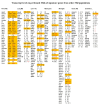Quantitative In-Depth Transcriptome Analysis Implicates Peritoneal Macrophages as Important Players in the Complement and Coagulation Systems
- PMID: 35163105
- PMCID: PMC8835655
- DOI: 10.3390/ijms23031185
Quantitative In-Depth Transcriptome Analysis Implicates Peritoneal Macrophages as Important Players in the Complement and Coagulation Systems
Abstract
To obtain a more detailed picture of macrophage (MΦ) biology, in the current study, we analyzed the transcriptome of mouse peritoneal MΦs by RNA-seq and PCR-based transcriptomics. The results show that peritoneal MΦs, based on mRNA content, under non-inflammatory conditions produce large amounts of a number of antimicrobial proteins such as lysozyme and several complement components. They were also found to be potent producers of several chemokines, including platelet factor 4 (PF4), Ccl6, Ccl9, Cxcl13, and Ccl24, and to express high levels of both TGF-β1 and TGF-β2. The liver is considered to be the main producer of most complement and coagulation components. However, we can now show that MΦs are also important sources of such compounds including C1qA, C1qB, C1qC, properdin, C4a, factor H, ficolin, and coagulation factor FV. In addition, FX, FVII, and complement factor B were expressed by the MΦs, altogether indicating that MΦs are important local players in both the complement and coagulation systems. For comparison, we analyzed human peripheral blood monocytes. We show that the human monocytes shared many characteristics with the mouse peritoneal MΦs but that there were also many major differences. Similar to the mouse peritoneal MΦs, the most highly expressed transcript in the monocytes was lysozyme, and high levels of both properdin and ficolin were observed. However, with regard to connective tissue components, such as fibronectin, lubricin, syndecan 3, and extracellular matrix protein 1, which were highly expressed by the peritoneal MΦs, the monocytes almost totally lacked transcripts. In contrast, monocytes expressed high levels of MHC Class II, whereas the peritoneal MΦs showed very low levels of these antigen-presenting molecules. Altogether, the present study provides a novel view of the phenotype of the major MΦ subpopulation in the mouse peritoneum and the large peritoneal MΦs and places the transcriptome profile of the peritoneal MΦs in a broader context, including a comparison of the peritoneal MΦ transcriptome with that of human peripheral blood monocytes and the liver.
Keywords: coagulation system; complement system; liver; mRNA; macrophage; monocyte; transcriptome.
Conflict of interest statement
The authors declare no conflict of interest.
Figures



Similar articles
-
Hepatitis C Virus-Induced Monocyte Differentiation Into Polarized M2 Macrophages Promotes Stellate Cell Activation via TGF-β.Cell Mol Gastroenterol Hepatol. 2016 Jan 8;2(3):302-316.e8. doi: 10.1016/j.jcmgh.2015.12.005. eCollection 2016 May. Cell Mol Gastroenterol Hepatol. 2016. PMID: 28090562 Free PMC article.
-
Macrophage dynamics are regulated by local macrophage proliferation and monocyte recruitment in injured pancreas.Eur J Immunol. 2015 May;45(5):1482-93. doi: 10.1002/eji.201445013. Epub 2015 Mar 19. Eur J Immunol. 2015. PMID: 25645754
-
IL-10 acts as a developmental switch guiding monocyte differentiation to macrophages during a murine peritoneal infection.J Immunol. 2012 Sep 15;189(6):3112-20. doi: 10.4049/jimmunol.1200360. Epub 2012 Aug 6. J Immunol. 2012. PMID: 22869902
-
Complement and coagulation crosstalk - Factor H in the spotlight.Immunobiology. 2023 Nov;228(6):152707. doi: 10.1016/j.imbio.2023.152707. Epub 2023 Jul 12. Immunobiology. 2023. PMID: 37633063 Review.
-
Reincarnation of ancient links between coagulation and complement.J Thromb Haemost. 2015 Jun;13 Suppl 1:S121-32. doi: 10.1111/jth.12950. J Thromb Haemost. 2015. PMID: 26149013 Review.
Cited by
-
Mast Cells are Dependent on Glucose Transporter 1 (GLUT1) and GLUT3 for IgE-mediated Activation.Inflammation. 2024 Oct;47(5):1820-1836. doi: 10.1007/s10753-024-02011-8. Epub 2024 Apr 3. Inflammation. 2024. PMID: 38565760 Free PMC article.
-
Mast Cell and Basophil Granule Proteases - In Vivo Targets and Function.Front Immunol. 2022 Jul 5;13:918305. doi: 10.3389/fimmu.2022.918305. eCollection 2022. Front Immunol. 2022. PMID: 35865537 Free PMC article. Review.
-
Quantitative Transcriptome Analysis of Purified Equine Mast Cells Identifies a Dominant Mucosal Mast Cell Population with Possible Inflammatory Functions in Airways of Asthmatic Horses.Int J Mol Sci. 2022 Nov 12;23(22):13976. doi: 10.3390/ijms232213976. Int J Mol Sci. 2022. PMID: 36430453 Free PMC article.
-
Phenotypic and Functional Heterogeneity of Monocytes and Macrophages.Int J Mol Sci. 2023 Sep 25;24(19):14525. doi: 10.3390/ijms241914525. Int J Mol Sci. 2023. PMID: 37833973 Free PMC article.
-
Single-cell transcriptomics delineates the immune cell landscape in equine lower airways and reveals upregulation of FKBP5 in horses with asthma.Sci Rep. 2023 Sep 27;13(1):16261. doi: 10.1038/s41598-023-43368-4. Sci Rep. 2023. PMID: 37758813 Free PMC article.
References
MeSH terms
Substances
Grants and funding
LinkOut - more resources
Full Text Sources
Research Materials
Miscellaneous

